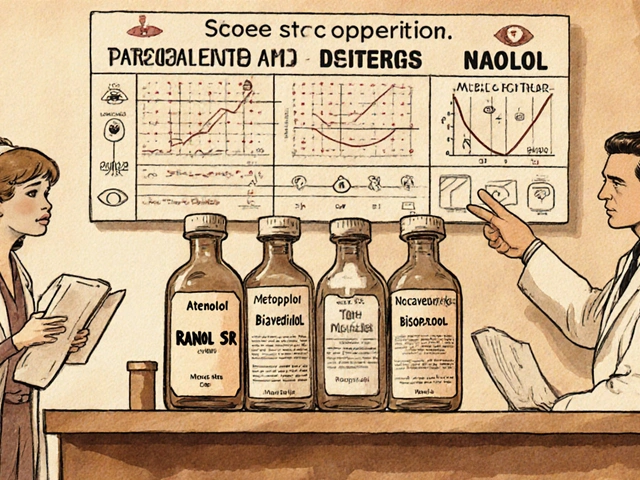Shots are no one’s favorite thing, but for a long time, treating type 2 diabetes pretty much guaranteed needles. That changed when DPP-4 inhibitors hit the scene. Suddenly, daily pills offered easier control, fewer side effects, and a totally different kind of approach to lowering blood sugar. Curious what’s really going on behind the pharmacy counter? You're not alone. These meds aren’t just about convenience — they shift how the body actually handles sugar, pushing the boundaries of what people with type 2 diabetes can expect from modern therapy.
How DPP-4 Inhibitors Work and Why They Matter
Raise your hand if you’d rather remember to pop a pill than mess with vials, needles, or tricky timing. That’s the first appeal of DPP-4 inhibitors: they arrive in pill form — nothing invasive. But what do they actually do? Picture this: your body naturally creates hormones called incretins, like GLP-1 and GIP, that help you pump out insulin right after you eat. The trouble is, a protein called DPP-4 rapidly chews up these hormones. Less GLP-1/GIP, less insulin, and — surprise — higher blood sugar.
DPP-4 inhibitors stop that breakdown, which means you keep more of those helpful incretins floating around after meals. Your body responds to food with a smarter, more natural insulin boost. This isn’t brute force sugar control — it’s more like a gentle nudge back to how things should work. Drugs like sitagliptin (better known as diabetes medication Januvia), saxagliptin, linagliptin, and alogliptin are all part of this family.
Here’s an interesting fact that surprises a lot of folks: DPP-4 inhibitors pretty much leave your weight alone. Unlike some diabetes meds that cause you to pack on pounds, these don't push the scale north. That’s a big relief if you’re already struggling to keep weight in check. Even more impressive, the risk for blood sugar crashes (hypoglycemia) is low, especially if you’re not mixing with insulin or older drugs like sulfonylureas. No wonder doctors are reaching for these more and more.
| DPP-4 Inhibitor | Brand Name | Dose Frequency | Main Benefits |
|---|---|---|---|
| Sitagliptin | Januvia | Once daily | Weight neutral, low hypoglycemia, oral formulation |
| Saxagliptin | Onglyza | Once daily | Weight neutral, flexible with kidney function |
| Linagliptin | Tradjenta | Once daily | No dose adjustment for kidney issues |
| Alogliptin | Nesina | Once daily | Well-tolerated, weight neutral |
Ask around and you’ll hear it: people appreciate how these pills slip into a daily routine without a fuss. No rigid meal schedules or countless checks needed. The safety factor is another story, though. DPP-4 inhibitors aren’t miracle drugs. If you have a history of pancreatitis, for instance, your doc will probably flag these right away. That said, the overall tolerance is good, with the most common "issue" being mild, stuffy nose, or a sore throat. That beats dangerous lows or sudden weight gain any day.
What tips can actually help someone get the most out of these meds? Start with the basics: make pill-taking as automatic as brushing your teeth so you don’t miss doses. Set an alarm on your phone or stash your tablet next to your morning coffee mug. If you’re taking other meds, ask your pharmacist about possible interactions — some DPP-4 inhibitors play better than others when it comes to kidney or liver function. And don’t assume every DPP-4 is equal for every situation. For example, linagliptin is a favorite when kidneys start to decline, because dosing stays the same even with reduced kidney function.

Limitations: What DPP-4 Inhibitors Can't Do (Yet)
For all their perks, DPP-4 inhibitors are not an all-in-one fix. They lower A1C (that three-month blood sugar average) less aggressively than some of the big guns. Depending on the person, expect a drop in A1C of about 0.5–0.8%. That’s nothing to sneeze at, but if your numbers are sky-high, your doctor will often recommend a combo approach from the start. Or, if you need fast, pronounced control, DPP-4s rarely work alone.
One thing that often gets lost in the hype: DPP-4 inhibitors do not offer the same heart or kidney benefits as some of the newer classes, like SGLT2 inhibitors or GLP-1 receptor agonists. Remember those late-night commercials touting heart disease risk? The evidence just isn’t as strong for DPP-4s. They’re neutral — so they don’t hurt, but they don’t go above and beyond the way SGLT2 or GLP-1 options can in protecting your heart and kidneys.
People sometimes get tripped up by the sheer number of meds on the market. Can you take a DPP-4 with metformin? Usually, yes — and often that’s the starting combo. But mixing with a GLP-1 agonist? There’s little benefit, since they operate on similar hormone pathways. No sense in doubling up on expensive meds that don’t add much hit together. The cost question lingers, too. While generics are starting to hit the shelves for some DPP-4s, these drugs have traditionally been pricier than metformin or sulfonylureas, which have been around for decades.
Let’s talk numbers: as of 2025, DPP-4s make up about one in every six prescriptions for oral diabetes agents worldwide. But that share has dipped a bit as guidelines shift to favor SGLT2s and GLP-1 agonists, especially in folks with heart or kidney risk. This isn’t because DPP-4s are unsafe or outdated — it’s because newer meds bring extra perks if you fit a specific health profile. For those with average risk, or those who don’t tolerate side effects from the flashier choices, DPP-4 inhibitors remain a go-to.
Tips for minimizing the letdowns? Don’t expect miracles for weight or for protecting your heart. Use your DPP-4 as part of a broader plan — exercise, smart food choices, and regular check-ins to fine-tune your regimen. And speak up if you develop anything odd: a rash, abdominal pain, or allergic reaction. These are rare, but better safe than sorry. If you notice swelling, shortness of breath, or severe joint pain (which happens in a tiny number of folks), ring your provider. For most, the ride is smooth, but staying alert matters.

What’s Next: Future Directions in DPP-4 Therapy
You might think the world of diabetes pills is set in stone, but research keeps churning. Even now, scientists are poking at ways to stretch out DPP-4’s benefits. There’s talk of combo pills (think DPP-4 paired with SGLT2 inhibitors), once-weekly formulations in the pipeline, and even tweaks that could address the subtle inflammation linked with type 2 diabetes. Some of these ideas are still in mice — but the promise? Smoother blood sugar, fewer pills, maybe even tackling diabetes complications beyond sugar alone.
Check out this twist: Certain DPP-4 inhibitors may have roles outside of diabetes, including treating immune problems and certain cancers. That’s right, some experts are looking into whether fiddling with the DPP-4 enzyme can help fight inflammation, or even slow certain types of tumor growth. Far-fetched? Science moves fast — what seems odd today sometimes becomes the new normal tomorrow.
Tools for tracking diabetes are changing fast, too. Imagine getting real-time blood sugar readouts via wearable devices, allowing DPP-4 doses to adapt based on what’s happening with your numbers, not just a set daily schedule. Intensive research is moving closer to this sort of feedback-driven medicine. The goal? Personalize treatment so much that you only need the exact amount of drug — not too little, not too much. Doing this means fewer side effects, better safety, and maybe even simpler routines for patients with busy lives.
Curious whether the classic DPP-4 pills like sitagliptin (Januvia) still stack up against all these next-generation options? Short answer: for folks just diagnosed, or with mild elevations in blood sugar, they’re still a smart pick. But as newer combo therapies become available, the lines will blur. For example, some trials are exploring DPP-4 blockers with built-in heart or kidney protection, targeting the people traditional DPP-4s never quite served best. Not every new idea will pan out — but the push to improve is stronger than ever.
One last thing: Sometimes “old” drugs like DPP-4 inhibitors stick around for a reason. They’re reliable, easy to take, and for thousands of people, they work well enough — especially when a patient can’t or won’t tolerate the headline-grabbing newcomers. So while the hype machine will keep spinning for whatever comes next in diabetes care, don’t overlook what these medications have already achieved. For anyone asking “What should I really expect from a DPP-4 inhibitor?” the answer is: steady sugar control, a gentle side effect profile, and the chance to focus on living, not just managing a disease.







Write a comment
Your email address will be restricted to us